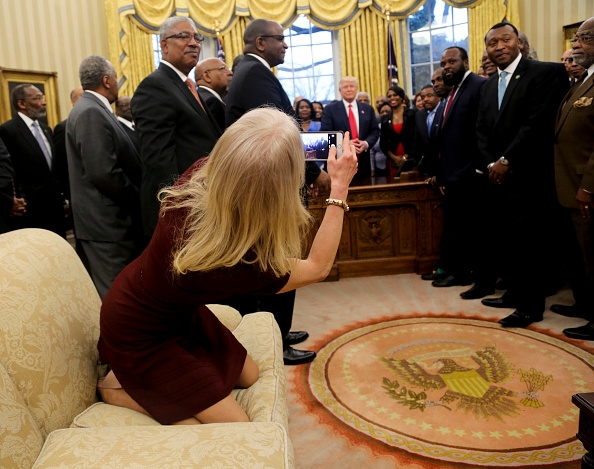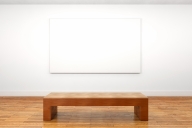You have /5 articles left.
Sign up for a free account or log in.

Kellyanne Conway in the Oval Office
Getty Images
“If you are going to study 16th-century French art, more power to you. I support the arts … but you are not going to get a job," declared Sam Clovis, Donald Trump’s campaign co-chair in an interview last May. Clovis was outlining the would-be president’s education policy, and art history served as a prime example of the kind of major that student loans, he argued, should not underwrite.
Since that interview, Trump has been elected the 45th president of the United States and, ironically -- or perhaps not -- his administration has been embroiled in more than its share of image-based controversies. For weeks following the inauguration, Trump and Press Secretary Sean Spicer attempted to explain why photographs of the National Mall appeared to reflect lower attendance at the event than the president perceived, or hoped, to be the case.
On Jan. 28, a day after Trump issued an executive order prohibiting refugees from Syria and individuals from six other countries from entering the United States, his daughter Ivanka posted a photo on Instagram of herself and husband Jared Kushner dressed to the nines for a black-tie event -- a gesture that earned her comparisons to Marie Antoinette. More recently, an image of Kellyanne Conway kneeling on a couch in the Oval Office quickly overshadowed the photo opportunity she was ostensibly documenting: the president’s meet and greet with leaders from the nation’s historically black colleges and universities.
In the face of the many aspects of the Trump administration that warrant attention, Clovis’s distant and passing remark about art history may seem inconsequential. But exploring the assumptions behind it actually offers a lot of insight into the administration’s stream of visual foibles and the way a liberal arts education prepares one to live and work in a world suffused by images.
This isn’t the first time art history has taken a hit in debates about the value of a liberal arts education. In 2014, President Obama famously told a room full of GE employees in Wisconsin, “I promise you folks can make a lot more, potentially, with skilled manufacturing or the trades than they might with an art history degree.”
Both Clovis’s and Obama’s comments betray the belief that art history is an elitist and insular enterprise. It enables you to appreciate the finer things in life -- expensive objects you might see at a museum, but could never afford to own, or things you might discuss “at a cocktail party” (the backhanded compliment of all backhanded compliments to an art historian). In his response to art history professor Ann Collins Johns’s criticism of his remarks in Wisconsin, Obama said the art history class he took in high school “has helped me take in a great deal of joy in my life that I might otherwise have missed.”
Art can, of course, alert you to the beauties of the world. I recently photographed some bright flowers seen, with difficultly, through a frosted window of an old church because they reminded me of pastels by the turn-of-the-20th-century French artist Odilon Redon. Without that point of reference, I might not have seen the flowers as a mark of the thriving community the old building still seems to foster, or I might have overlooked the site altogether.
But art history has also documented and been witness to and participant in some of the world’s greatest injustices. An introductory art history course would be remiss if it didn’t address 19th-century Spanish artist Francisco Goya’s The Third of May 1808 in Madrid, which depicts French soldiers executing Spanish freedom fighters in the wake of the popular revolt against Joseph Napoleon, whose brother had recently installed him as king of Spain. In my introductory class, we also talk about 18th-century French artist Antoine Watteau and the ways his elegant and lighthearted paintings portrayed -- but also abetted -- the aristocratic indulgences that would ultimately bring about the Revolution.
More recently, contemporary artist Kara Walker’s installations of black paper silhouettes have become a staple of classes in African-American art, American art and contemporary art. Applied directly to the museum or gallery wall, her antebellum characters engage in graphic sexual and violent acts, sending up genteel white culture -- from the Southern plantation to the modern museum -- and the ways in which it has sustained, enabled and promulgated racist ideas.
Art history is not, as Clovis’s and Obama’s remarks imply, a litany of obscure facts about artists’ lives, a catalog of auction records or the categorization of styles. It is about representation. It asks who or what is depicted, how, where and why -- questions central to the most pressing political and social issues in the United States today. Racial profiling, transgender rights and immigration, to name a few, are all about equal rights and the ways in which they are enforced or thwarted on the basis of visual cues and popular perceptions. To study art history is to learn the ways in which images -- from 16th-century French paintings to contemporary memes -- wield power, shape identity and construct who we are as well as what we think about other people.
Of course, undergraduates (and their parents) as well as graduate students are right to think about their career prospects, and should be encouraged to do so. But one of the many things art history and, indeed, the liberal arts teach us is that professional success and personal growth are not as mutually exclusive as Clovis’s comments suggest. They are both premised upon recognizing and appreciating how things might look to someone else. In that sense, based on the photographs that have swirled around the current administration, art history may have its place in our world, after all.








